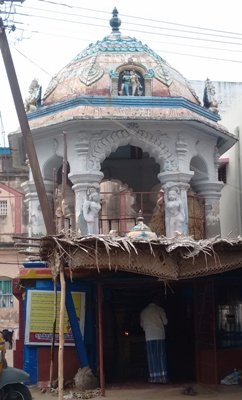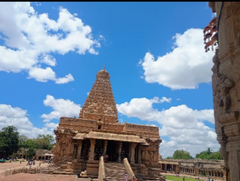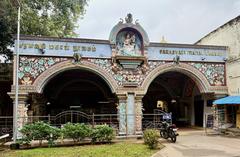
Thanjavur Nalukal Mandapa Anjaneya Temple Visiting Hours, Tickets, and Historical Significance
Date: 17/08/2024
Introduction
The Thanjavur Nalukal Mandapa Anjaneya Temple, also known as the Sree Moola Anjaneya Swamy Temple, stands as a testament to the rich cultural and religious heritage of Thanjavur, Tamil Nadu, India. Unlike typical Anjaneya temples, which are often modest in scale, this temple is renowned for its architectural grandeur and historical significance. Constructed under the guidance of Sri Sethu Bhawa Swami by Sri Pratapah Simha, it features a three-tier rajagopuram (gateway tower) and a dwaja sthambam (flagpole), making it one of the largest ancient temples dedicated to Lord Anjaneya (source). Its location in the ‘Vayu moolai’ (north-west corner) of Thanjavur aligns with the principles of Vasthu Sastra, enhancing its spiritual energy and significance (source). The temple not only serves as a place of worship but also as a cultural hub, reflecting the artistic and architectural prowess of the Nayak period, during which it was established. This guide aims to provide comprehensive information on the temple’s history, architectural features, cultural significance, visitor information, and nearby attractions to ensure a fulfilling and respectful visit.
Table of Contents
- [Introduction](#introductionintroduction)
- [History of Thanjavur Nalukal Mandapa Anjaneya Temple](#history-of-thanjavur-nalukal-mandapa-anjaneya-templehistory-of-thanjavur-nalukal-mandapa-anjaneya-temple)
- [Origins and Construction](#origins-and-constructionorigins-and-construction)
- [Architectural Significance](#architectural-significancearchitectural-significance)
- [Cultural and Religious Importance](#cultural-and-religious-importancecultural-and-religious-importance)
- [Historical Context](#historical-contexthistorical-context)
- [Renovations and Additions](#renovations-and-additionsrenovations-and-additions)
- [Comparison with Other Anjaneya Temples](#comparison-with-other-anjaneya-templescomparison-with-other-anjaneya-temples)
- [Influence of Vasthu Sastra](#influence-of-vasthu-sastrainfluence-of-vasthu-sastra)
- [Role in Community and Pilgrimage](#role-in-community-and-pilgrimagerole-in-community-and-pilgrimage)
- [Preservation Efforts](#preservation-effortspreservation-efforts)
- [Visitor Information](#visitor-informationvisitor-information)
- [Visiting Hours](#visiting-hoursvisiting-hours)
- [Ticket Prices](#ticket-pricesticket-prices)
- [Guided Tours](#guided-toursguided-tours)
- [Travel Tips](#travel-tipstravel-tips)
- [Nearby Attractions](#nearby-attractionsnearby-attractions)
- [Brihadisvara Temple](#brihadisvara-templebrihadisvara-temple)
- [Thanjavur Palace](#thanjavur-palacethanjavur-palace)
- [Saraswathi Mahal Library](#saraswathi-mahal-librarysaraswathi-mahal-library)
- [Conclusion](#conclusionconclusion)
- [FAQs](#faqsfaqs)
- [Sources](#sourcessources)
History of Thanjavur Nalukal Mandapa Anjaneya Temple
Origins and Construction
The temple was constructed under the guidance of Sri Sethu Bhawa Swami by Sri Pratapah Simha. It features a three-tier rajagopuram (gateway tower) and a dwaja sthambam (flagpole), making it one of the largest ancient temples dedicated to Lord Anjaneya (source).
Architectural Significance
Located in the North-West corner of Thanjavur, known as ‘Vayu moolai,’ the temple’s architecture includes an eighteen-pillared alankara mandapam (decorative hall), showcasing intricate craftsmanship (source).
Cultural and Religious Importance
The temple is a significant cultural and religious site. It is believed that praying to Sri Anjaneya Murthy while standing on the floor corresponding to one’s Rasi (zodiac sign) can fulfill the devotee’s wishes, attracting devotees from across the country (source).
Historical Context
Built during a period when Thanjavur was a significant cultural and political center, the temple reflects the era’s emphasis on religious and cultural patronage under the influence of the Chola dynasty.
Renovations and Additions
The temple has undergone several renovations to preserve its structural integrity and enhance its spiritual ambiance. These efforts ensure it remains a vibrant center of worship and cultural activities.
Comparison with Other Anjaneya Temples
Compared to other Anjaneya temples, such as the one in Iyenkulam near Kanchipuram, the Thanjavur temple’s three-tier rajagopuram and eighteen-pillared alankara mandapam make it unique and significant (source).
Influence of Vasthu Sastra
The temple’s location in ‘Vayu moolai’ aligns with Vasthu Sastra, believed to enhance its spiritual energy, reflecting a deep understanding of traditional architectural practices (source).
Role in Community and Pilgrimage
The temple plays a significant role in the local community and remains a major pilgrimage site, providing free meals to pilgrims and wayfarers, underscoring its role as a community center (source).
Preservation Efforts
Ongoing preservation efforts, including renovations and repairs, maintain the temple’s structural and aesthetic integrity, ensuring it remains a vibrant center of worship and cultural activities.
Visitor Information
Visiting Hours
The temple is open to visitors from 6:00 AM to 12:00 PM and from 4:00 PM to 8:00 PM daily.
Ticket Prices
There is no entry fee for visiting the temple. However, donations are welcome to support its maintenance and charitable activities.
Guided Tours
Guided tours are available upon request. Visitors can book these tours at the temple office or through the official website.
Travel Tips
- Best times to visit are early mornings and late afternoons to avoid the midday heat.
- Wear modest clothing as it is a place of worship.
- Photography is allowed, but be respectful of the surroundings and other devotees.
Nearby Attractions
Brihadisvara Temple
A UNESCO World Heritage Site known for its grandeur and historical significance.
Thanjavur Palace
Home to an art gallery, library, and museum showcasing Chola artifacts.
Saraswathi Mahal Library
One of the oldest libraries in Asia, housing ancient manuscripts and rare books.
Conclusion
The Thanjavur Nalukal Mandapa Anjaneya Temple is a remarkable site of religious architecture and cultural heritage. Its unique features, historical significance, and spiritual importance make it a must-visit for devotees and tourists alike. Ongoing preservation efforts ensure that it continues to be a vibrant center of worship and cultural activities for generations to come.
FAQs
What are the visiting hours for Thanjavur Nalukal Mandapa Anjaneya Temple?
The temple is open from 6:00 AM to 12:00 PM and from 4:00 PM to 8:00 PM daily.
How much are the tickets?
There is no entry fee, but donations are welcome.
Is there a guided tour available?
Yes, guided tours are available upon request and can be booked at the temple office or through the official website.


